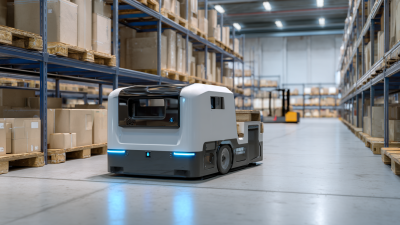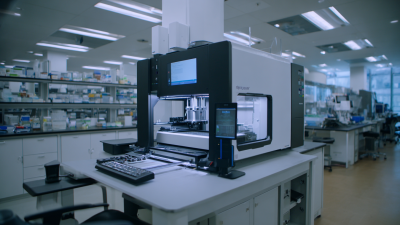Exploring the Future of AMR Robots in Smart Warehousing and Supply Chain Optimization
As we delve into the dynamic intersection of automation and logistics, the role of AMR robots in smart warehousing and supply chain optimization becomes increasingly pivotal. According to industry expert Dr. Emily Chen, a leading researcher in robotic automation, “AMR robots are not just enhancing efficiency; they are transforming the very architecture of logistics systems.” This assertion underscores the potential of AMR robots to redefine operational frameworks, making them essential for the future of the supply chain.
 The deployment of AMR robots facilitates a seamless warehouse operation, where real-time data and automated processes converge to create smarter environments. These robots navigate complex layouts, manage inventory autonomously, and optimize workflows with extraordinary precision. As the demand for accelerated delivery and increased reliability grows, the significance of AMR technology cannot be overstated. It is poised to address challenges such as labor shortages and rising operational costs, thereby making it a cornerstone of sustainable supply chain practices.
The deployment of AMR robots facilitates a seamless warehouse operation, where real-time data and automated processes converge to create smarter environments. These robots navigate complex layouts, manage inventory autonomously, and optimize workflows with extraordinary precision. As the demand for accelerated delivery and increased reliability grows, the significance of AMR technology cannot be overstated. It is poised to address challenges such as labor shortages and rising operational costs, thereby making it a cornerstone of sustainable supply chain practices.
In conclusion, exploring the future of AMR robots illuminates the transformative impact of this technology on the logistics landscape. By embracing these advancements, businesses not only stand to enhance their efficiency but also their agility in a rapidly evolving market. As we look ahead, the integration of AMR robots will undoubtedly shape the future of smart warehousing and drive strategic innovations within the supply chain.
Benefits of AMR Robots in Enhancing Warehouse Efficiency and Productivity
The integration of Autonomous Mobile Robots (AMR) in smart warehousing is revolutionizing the way logistics operations are conducted. One significant benefit of AMR robots is their ability to enhance warehouse efficiency. By automating routine tasks such as picking, sorting, and transporting goods, AMR robots significantly reduce the time products spend in transit within the warehouse. This precision in operations allows for quicker order processing, ultimately leading to improved customer satisfaction.
**Tip:** To maximize the benefits of AMR robots, invest in sophisticated warehouse management systems that can seamlessly integrate with these robots. This ensures that the operational data is utilized effectively, allowing for real-time decision-making.
Moreover, AMR robots contribute to improved productivity by enabling human workers to focus on more complex tasks that require critical thinking and creativity. With the repetitive and time-consuming tasks handled by robots, employees can engage in activities that directly impact business growth and innovation. The flexibility of AMR robots also means they can adapt to changing warehouse layouts, ensuring continuous operation without the need for extensive reprogramming.
**Tip:** Regular training and upskilling of warehouse staff alongside AMR integration can foster a culture of collaboration between humans and robots, enhancing overall warehouse performance.
Key Technologies Driving AMR Development for Supply Chain Solutions
The future of Autonomous Mobile Robots (AMR) in smart warehousing and supply chain optimization is shaped by several key technologies that are driving their development and implementation. According to recent market research, the global warehouse robotics market is projected to grow significantly, with an estimated compound annual growth rate (CAGR) exceeding 50% from 2022 to 2032. This rapid expansion is attributed to increasing demand for automation and the efficiency these advanced technologies bring to warehouse operations.
A breakdown of the AMR market reveals several types, including tow tractors, automated forklifts, collision-avoidance vehicles, and assembly line robots. Each category plays a vital role in enhancing productivity and accuracy in inventory management. Notably, the application of laser navigation technology continues to dominate, providing superior precision in navigation compared to magnetic and visual systems. As businesses strive to improve operational efficiency, investment in these technologies becomes crucial.
**Tips:** Implementing AMR solutions can drastically reduce labor costs and improve inventory tracking accuracy. Warehouses adopting these technologies have reported up to a 30% decrease in operational costs. Additionally, firms should assess their specific needs to choose the right type of AMR tailored to their logistical challenges, ensuring maximum return on investment.
Challenges and Limitations of Implementing AMR Robots in Warehousing
As the adoption of Autonomous Mobile Robots (AMRs) in smart warehousing accelerates, several challenges arise that can hinder their effectiveness. One significant limitation is the integration of AMRs with existing warehouse management systems. Many warehouses operate on outdated software and hardware, making it difficult to seamlessly incorporate AMR technology. This can lead to inefficiencies and increased operational costs, undermining the potential benefits of automation.

Tip: Regularly assess your warehouse layout and processes to identify areas for improvement before integrating AMRs.
Lastly, the initial investment for AMR technology can be a barrier for many companies. While the long-term benefits may outweigh the costs, organizations must carefully consider their budget and potential return on investment. Understanding the specific needs of the warehouse and selecting the right type of AMR can significantly influence the success of the implementation.
Tip: Start with a pilot program to evaluate the performance and ROI of AMRs in your warehousing operations before committing to full-scale implementation.
Future Trends: How AMR Robots Will Shape Smart Warehousing Strategies
As the logistics landscape evolves, automated mobile robots (AMRs) are set to redefine smart warehousing strategies. According to a report by the International Federation of Robotics, the use of AMR technology in warehouses is expected to grow at an annual rate of 20% through 2026. This rapid adoption is not merely a trend; it's a pivotal shift towards enhancing efficiency and reducing operational costs. AMRs streamline workflows by automating repetitive tasks, allowing human workers to focus on more value-added activities, thus optimizing overall supply chain performance.

Tips: When integrating AMRs into your warehouse, consider a phased approach. Start with pilot programs to assess their impact on workflow before full-scale deployment. Additionally, ensure that your workforce is adequately trained to collaborate effectively with AMRs, fostering a culture of innovation and adaptability.
Future trends indicate that AMRs will become more sophisticated, with advancements in AI and machine learning enabling robots to navigate complex environments autonomously. A study by Logistics Management suggests that companies utilizing AMRs can achieve a 30% increase in throughput while minimizing errors. As businesses continue to explore these technologies, those that invest in AMRs will likely gain a competitive edge in both warehousing and broader supply chain optimization.
Tips: Regularly evaluate your operational metrics to measure the success of AMR integration. This allows you to make data-driven decisions and adjustments that will further enhance your warehouse efficiency.
Case Studies: Successful AMR Integration in Leading Supply Chain Operations
As the integration of Autonomous Mobile Robots (AMRs) into supply chain operations continues to evolve, leading companies are leveraging these technologies to enhance efficiency and streamline processes. Recent case studies have highlighted successful implementations of AMRs in warehouses, where the robots operate alongside human workers to optimize inventory management and improve order fulfillment. For instance, in one case, the introduction of AMRs reduced picking times by over 30%, demonstrating their potential to transform logistics operations.
Moreover, these success stories emphasize the importance of proper investment and innovative strategies in maximizing the value derived from AMR technology. Companies that offer comprehensive training programs and maintain seamless communication between human operators and AMRs create an environment where technology can thrive. This harmonious integration not only boosts productivity but also aligns with the principles of sustainable supply chain management, contributing to broader goals like corporate social responsibility and circular economy integration. The future of AMR robots in smart warehousing promises to redefine supply chain efficiency while adhering to sustainable practices.
Future Trends of AMR Robots in Supply Chain Optimization
This chart illustrates the projected adoption rate of Autonomous Mobile Robots (AMR) in supply chain operations over the next five years, highlighting an increasing trend as organizations optimize their warehousing processes.
Related Posts
-

Exploring the Future of AMR Robots in Everyday Life and Their Impact on Our Daily Activities
-

How to Maximize Efficiency with AMR Robots: Insights from the 2023 Logistics Automation Report
-

How to Create a Robot: A Step-by-Step Guide to Build Your First Automation Machine
-

Ultimate Guide to Mastering Agile Robotics for Business Success
-

Revolutionizing Research Efficiency through Lab Robotics and Automated Workflows in Life Sciences
-

How to Create Your Own Robot at Home with Simple Materials and Step by Step Guide